Japan
- 格式:doc
- 大小:49.00 KB
- 文档页数:6
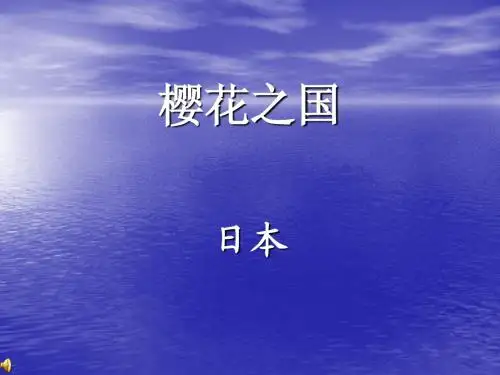
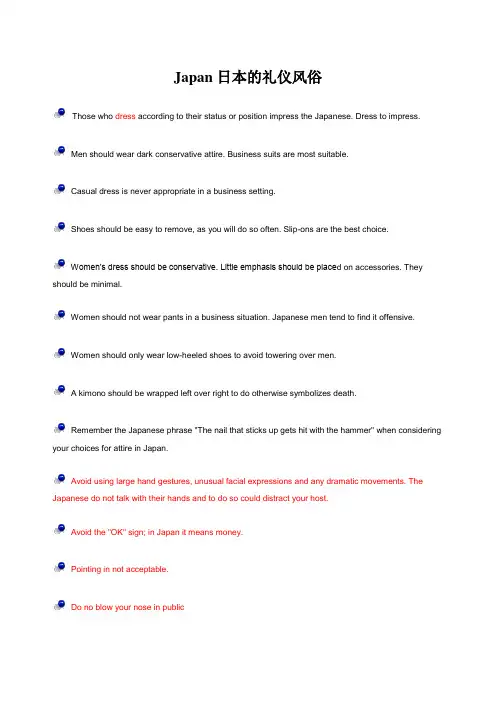
Japan日本的礼仪风俗Those who dress according to their status or position impress the Japanese. Dress to impress.Men should wear dark conservative attire. Business suits are most suitable.Casual dress is never appropriate in a business setting.Shoes should be easy to remove, as you will do so often. Slip-ons are the best choice.Women’s dress should be conservative. Little emphasis should be place d on accessories. They should be minimal.Women should not wear pants in a business situation. Japanese men tend to find it offensive.Women should only wear low-heeled shoes to avoid towering over men.A kimono should be wrapped left over right to do otherwise symbolizes death.Remember the Japanese phrase "The nail that sticks up gets hit with the hammer" when considering your choices for attire in Japan.Avoid using large hand gestures, unusual facial expressions and any dramatic movements. The Japanese do not talk with their hands and to do so could distract your host.Avoid the "OK" sign; in Japan it means money.Pointing in not acceptable.Do no blow your nose in publicPersonal space is valued. Because the Japanese live in such a densely populated area, they value their personal space.A smile can have double meaning. It can express either joy or displeasure. Use caution with your facial expressions. They can be easily misunderstood.The Japanese are not uncomfortable with silence. They use it to their advantage in many situations. Allow your host to sit in silence.BehaviorThe word for toasting is kampai, pronounced 'kahm-pie'. When toasting the glass is never left unfilled. Drinking is an important part of Japanese culture. It is a way to relieve business stress.Never pour a drink yourself; always allow someone else to do it for you.Most business entertaining is done in restaurants or bars after business hours. Often in karaoke or "hostess bars." Businesswomen should not attend "hostess bars."Let the host order the meal and pay. Business may be discussed at dinner during these events.Japanese rarely entertain in the home. If you are invited to the home of your Japanese host, consider it a great honor and display a tremendous amount of appreciation.If you are invited to a social event, punctuality is not expected. It is the custom to be "fashionably late."If you do take your host out insist upon paying. The Japanese will refuse but insist. They will prefer that you choose a Western-style restaurant when entertain them.Key phrases to learn are "itadakimasu" at the beginning of dinner, and "gochisou-sama-deshita" at the end. It is polite use these phrase and it will show you host that you have enjoyed the meal."Sumimasen" (excuse-me) is a very useful term to add to your vocabulary along with the phrase "kekko desu" (I've had enough).It is perfectly acceptable to slurp your noodles. Doing so will exhibit your enjoyment of your food. To do otherwise, indicates that your meal was not a pleasant one.Do not openly display money. It is rare to see it given from person to person in Japan. It is important to use an envelope to pass money.In Asia the number 14 is bad luck, because in Japanese it sounds like the word ‘shuh-shuh’, which sounds like the word for death.Tipping is not expected.Style is tantamount. The gift itself is of little importance, the ceremony surrounding it is very important.Always wrap gifts. The selection of the wrapping paper is critical. Do not give anything wrapped inwhite as it symbolizes death. Do not use bright colors or bows to wrap the gift. It is better to have the hotel or the store wrap the gift to ensure that it is appropriate.Do not surprise the recipient with the gift. Give your host some warning during the evening that you intend to give them a present.Give the gift with both hands and accept gifts with hands.Generally, gifts will not be opened in your presence. If your host insist that you open the gift do so gingerly. They take pride in gift wrapping, show that you appreciation the effort.Do not give gifts in odd number or the number four, as odd numbers are bad luck and four sounds like the word for death in Japanese.Gifts should be given at the end of a visit.Do not admire anything belonging to your host too closely. The Japanese strive to please; you may be rewarded for your admiration.The most popular gift giving occasions in Japan are oseibo, which falls at the end of the year andO-chugen which falls during the middle of the year.Good gift ideas include top choice beef, fruit and alcohol such as brandy, quality whiskey andBourbon along with excellent wines. They also appreciate gifts from high-end department stores like Saks and Neiman Marcus.The Japanese frown on open displays of affection. They do not touch in public. It is highly inappropriate to touch someone of the opposite sex in public.CommunicationsIn Japan, business cards are called meishi. Japanese give and receive meishi with both hands. Itshould be printed in your home language on one side and Japanese on the other. Present the card with the Japanese language side up.The card will contain the name and title along with the company name, address and telephonenumber of the businessman. In Japan, businessmen are call "sarariman." A sarariman who does not have aTake special care in handling cards that are given to you. Do not write on the card. Do not put the cardin you pocket or wallet, as either of these actions will be viewed as defacing or disrespecting the business card. Upon receipt of the card, it is important to make a photocopy of the name and title of the individual in your mind. Examine the card carefully as a show of respect.In a business situation, business cannot begin until the meishi exchange process is complete.The customary greeting is the bow. However, some Japanese may greet you with a handshake, albeit a weak one. Do not misinterpret a weak handshake as an indication of character.If you are greeted with a bow, return with a bow as low as the one you received. How low you bowdetermines the status of the relationship between you and the other individual. When you bow keep your eyes low and your palms flat next to your thighs. The business card should be given after the bow. This is very important to remember.In introductions use the person’s last name plus the word san which means Mr. or Ms. The Japaneseprefer to use last names. Do not request that they call you by your first name only. If you are uncertain about the pronunciation of a name, ask for assistance.Understand that the Japanese prefer not to use the word no. If you ask a question they may simply respond with a yes but clearly mean no. Understanding this is critical in the negotiation process.In Asia the number 4 is bad luck, because in Japanese it sounds like the word ‘shuh-shuh’, which sounds like the word for death.Dress Etiquette. Business attire is conservative.. Men should wear dark-coloured, conservative business suits.. Women should dress conservatively.Body Language1.Japanese people prefer not to stand close to others.2.Try and avoid touching others.3.Do not take a smile as being a signal of happiness, the Japanese smile when mad,embarrassed, sad or disappointed.4.While sitting, don’t show the bottom of your shoes.5.It is rude to talk to someone when leaving your hands in your pockets.6.Put your hand in front of your face. Make sure your palm is facing towards your face.Then wave it back and forth, this is a polite way to answer “no” or “I don’t know” to acompliment.7.It is considered rude to stare at someone. Eye contact isn’t polite.8.Don’t lean against anything, a chair, a wall, a door, etc…9.When visiting someone, sit towards the edge to show proper respect and leaning back means closeness (such as a childhood friend).Business Negotiation. The Japanese are non-confrontational.. They have a difficult time saying 'no', so you must be vigilant at observing their non-verbal communication.. It is best to phrase questions so that they can answer yes. For example, do you disagree with this? Group decision-making and consensus are important.. Written contracts are required.. The Japanese often remain silent for long periods of time. Be patient and try to work out if your Japanese colleagues have understood what was said.. Japanese prefer broad agreements and mutual understanding so that when problems arise they can be handled flexibly.. Using a Japanese lawyer is seen as a gesture of goodwill. Note that Japanese lawyers are quite different from Western lawyers as they are much more functionary.. Never lose your temper or raise your voice during negotiations.. Some Japanese close their eyes when they want to listen intently.. The Japanese seldom grant concession. They expect both parties to come to the table with their best offer.. The Japanese do not see contracts as final agreements so they can be renegotiated.Dining EtiquetteOn the rare occasion you are invited to a Japanese house:. Remove your shoes before entering and put on the slippers left at the doorway.. Leave your shoes pointing away from the doorway you are about to walk through.. Arrive on time or no more than 5 minutes late if invited for dinner.. If invited to a large social gathering, arriving a little bit later than the invitation is acceptable, although punctuality is always appreciated.. Unless you have been told the event is casual, dress as if you were going into the office.. If you must go to the toilet, put on the toilet slippers and remove them when you are finished. Meeting Etiquette. Greetings in Japan are very formal and ritualized.. It is important to show the correct amount of respect and deference to someone based upon their status relative to your own.. If at all possible, wait to be introduced.. It can be seen as impolite to introduce yourself, even in a large gathering.. While foreigners are expected to shake hands, the traditional form of greeting is the bow. How far you bow depends upon your relationship to the other person as well as the situation. The deeperyou bow, the more respect you show.. A foreign visitor ('gaijin') may bow the head slightly, since no one expects foreigners to generally understand the subtle nuances of bowing.Gift Giving Etiquette. Gift-giving is highly ritualistic and meaningful.. The ceremony of presenting the gift and the way it is wrapped is as important--sometimes more important--than the gift itself.. Gifts are given for many occasions.. The gift need not be expensive, but take great care to ask someone who understands the culture to help you decide what type of gift to give.. Good quality chocolates or small cakes are good ideas.. Do not give lilies, camellias or lotus blossoms as they are associated with funerals.. Do not give white flowers of any kind as they are associated with funerals.. Do not give potted plants as they encourage sickness, although a bonsai tree is always acceptable. . Give items in odd numbers, but not 9.. If you buy the gift in Japan, have it wrapped.. Pastel colours are the best choices for wrapping paper.. Gifts are not opened when received.Understanding of Foreign Ways. Japanese understand that it is very difficult for foreigners to work in Japan.. They will not expect you to speak or read Japanese, or be conversant with their strict cultural nuances and protocol.. Mistakes are allowed as long as genuine respect is shown at all times.. They will usually try to help you but often feel embarrassment at their own lack of understanding or English language ability.Relationships & Communication. The Japanese prefer to do business on the basis of personal relationships.. In general, being introduced or recommended by someone who already has a good relationship with the company is extremely helpful as it allows the Japanese to know how to place you in a hierarchy relative to themselves.. One way to build and maintain relationships is with greetings / seasonal cards.. It is important to be a good correspondent as the Japanese hold this in high esteem.Business Meeting Etiquette. Appointments are required and, whenever possible, should be made several weeks in advance. . It is best to telephone for an appointment rather than send a letter, fax or email.. Punctuality is important. Arrive on time for meetings and expect your Japanese colleagues will do the same.. Since this is a group society, even if you think you will be meeting one person, be prepared for a group meeting.. The most senior Japanese person will be seated furthest from the door, with the rest of the people in descending rank until the most junior person is seated closest to the door.. It may take several meetings for your Japanese counterparts to become comfortable with you and be able to conduct business with you.. This initial getting to know you time is crucial to laying the foundation for a successful relationship. . You may be awarded a small amount of business as a trial to see if you meet your commitments. . If you respond quickly and with excellent service, you prove your ability and trustworthiness.. Never refuse a request, no matter how difficult or non- profitable it may appear. The Japanese are looking for a long-term relationship.. Always provide a package of literature about your company including articles and client testimonials.. Always give a small gift, as a token of your esteem, and present it to the most senior person at the end of the meeting. Your Japanese contact can advise you on where to find something appropriate.GreetingsGreetings are considered to be of extreme importance in Japanese culture. Students in elementary and secondary schools are often admonished to deliver greetings with energy and vigor. A lazy greeting is regarded with the type of disdain that would accompany a limp handshake in parts of the West.Simply walking off without saying anything is frowned upon. When parting, instead of simply saying goodbye, it is common to make a wish to meet again.。
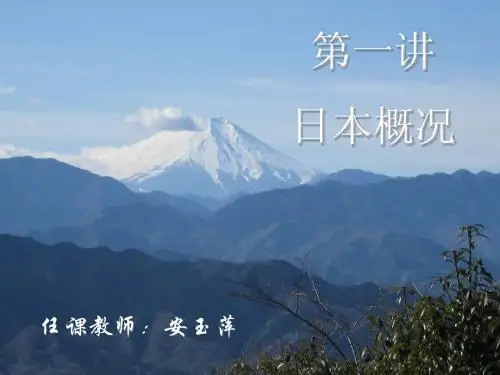

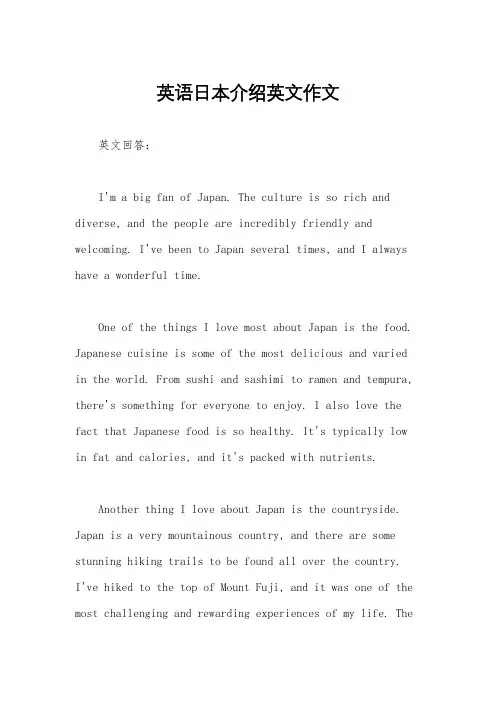
英语日本介绍英文作文英文回答:I'm a big fan of Japan. The culture is so rich and diverse, and the people are incredibly friendly and welcoming. I've been to Japan several times, and I always have a wonderful time.One of the things I love most about Japan is the food. Japanese cuisine is some of the most delicious and varied in the world. From sushi and sashimi to ramen and tempura, there's something for everyone to enjoy. I also love the fact that Japanese food is so healthy. It's typically low in fat and calories, and it's packed with nutrients.Another thing I love about Japan is the countryside. Japan is a very mountainous country, and there are some stunning hiking trails to be found all over the country. I've hiked to the top of Mount Fuji, and it was one of the most challenging and rewarding experiences of my life. Theviews from the top are simply breathtaking.Of course, no visit to Japan would be complete without spending some time in Tokyo. Tokyo is one of the mostvibrant and exciting cities in the world. There's something to do for everyone, from shopping and dining to sightseeing and nightlife. I love to spend my time in Tokyo exploringthe different neighborhoods, each with its own unique character.I've only scratched the surface of all that Japan hasto offer, but I'm already planning my next trip. I can'twait to go back and experience more of this amazing country.中文回答:我非常喜欢日本。
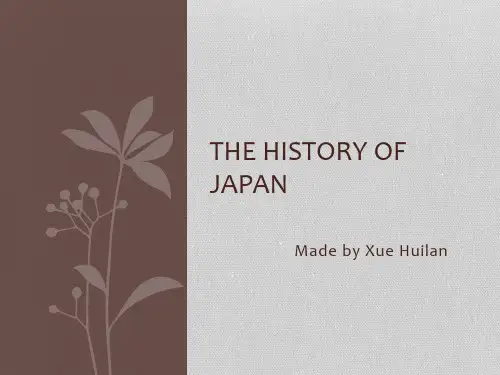
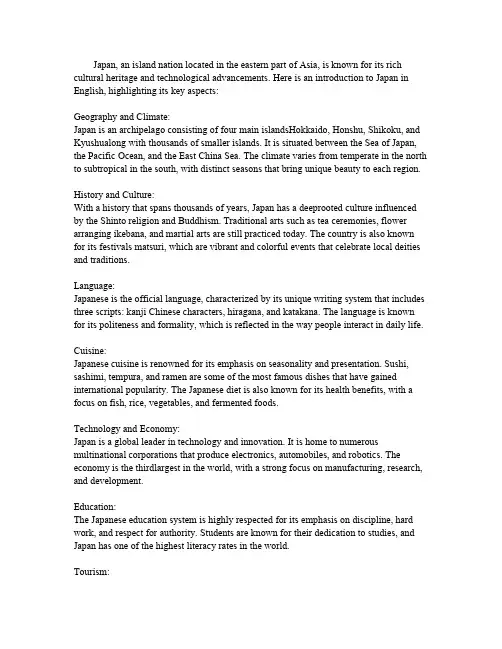
Japan,an island nation located in the eastern part of Asia,is known for its rich cultural heritage and technological advancements.Here is an introduction to Japan in English,highlighting its key aspects:Geography and Climate:Japan is an archipelago consisting of four main islandsHokkaido,Honshu,Shikoku,and Kyushualong with thousands of smaller islands.It is situated between the Sea of Japan, the Pacific Ocean,and the East China Sea.The climate varies from temperate in the north to subtropical in the south,with distinct seasons that bring unique beauty to each region.History and Culture:With a history that spans thousands of years,Japan has a deeprooted culture influenced by the Shinto religion and Buddhism.Traditional arts such as tea ceremonies,flower arranging ikebana,and martial arts are still practiced today.The country is also known for its festivals matsuri,which are vibrant and colorful events that celebrate local deities and traditions.Language:Japanese is the official language,characterized by its unique writing system that includes three scripts:kanji Chinese characters,hiragana,and katakana.The language is known for its politeness and formality,which is reflected in the way people interact in daily life.Cuisine:Japanese cuisine is renowned for its emphasis on seasonality and presentation.Sushi, sashimi,tempura,and ramen are some of the most famous dishes that have gained international popularity.The Japanese diet is also known for its health benefits,with a focus on fish,rice,vegetables,and fermented foods.Technology and Economy:Japan is a global leader in technology and innovation.It is home to numerous multinational corporations that produce electronics,automobiles,and robotics.The economy is the thirdlargest in the world,with a strong focus on manufacturing,research, and development.Education:The Japanese education system is highly respected for its emphasis on discipline,hard work,and respect for authority.Students are known for their dedication to studies,and Japan has one of the highest literacy rates in the world.Tourism:Tourism in Japan offers a mix of ancient traditions and modern attractions.From the historic temples of Kyoto to the bustling streets of Tokyo,visitors can experience a blend of old and new.The country also boasts natural wonders such as Mount Fuji,hot springs onsen,and beautiful cherry blossoms in spring.Social Etiquette:Japanese society places a high value on harmony and respect.Bowing is a common form of greeting,and there are specific rules for giftgiving and dining etiquette.Punctuality is also highly regarded in both social and professional settings.Transportation:Japans transportation system is known for its efficiency and punctuality.The Shinkansen, or bullet train,is a highspeed rail network that connects major cities.Public transportation in urban areas is extensive,and the country also has an extensive road network for driving and cycling.In conclusion,Japan is a country where tradition and modernity coexist,offering a unique blend of experiences for visitors and residents alike.Its rich history,technological advancements,and cultural practices make it a fascinating place to explore and learn from.。
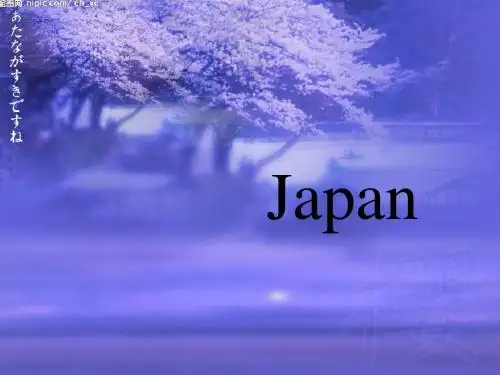
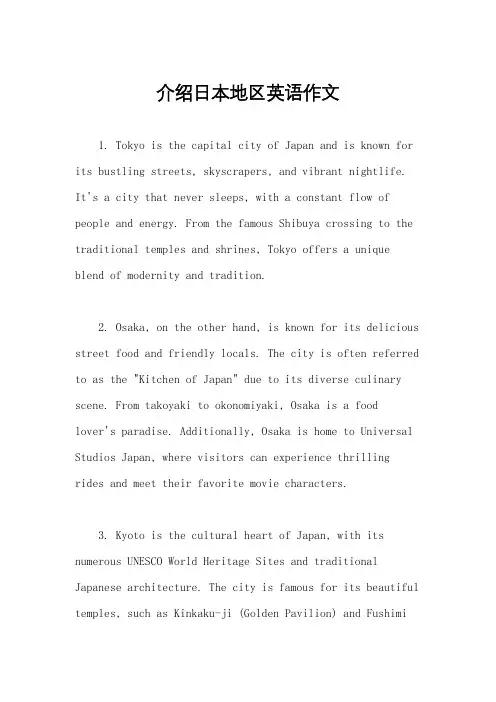
介绍日本地区英语作文1. Tokyo is the capital city of Japan and is known for its bustling streets, skyscrapers, and vibrant nightlife.It's a city that never sleeps, with a constant flow of people and energy. From the famous Shibuya crossing to the traditional temples and shrines, Tokyo offers a unique blend of modernity and tradition.2. Osaka, on the other hand, is known for its delicious street food and friendly locals. The city is often referred to as the "Kitchen of Japan" due to its diverse culinary scene. From takoyaki to okonomiyaki, Osaka is a foodlover's paradise. Additionally, Osaka is home to Universal Studios Japan, where visitors can experience thrilling rides and meet their favorite movie characters.3. Kyoto is the cultural heart of Japan, with its numerous UNESCO World Heritage Sites and traditional Japanese architecture. The city is famous for its beautiful temples, such as Kinkaku-ji (Golden Pavilion) and FushimiInari Taisha, known for its thousands of vermilion torii gates. Kyoto is also known for its traditional geishaculture and tea ceremonies, providing visitors with a glimpse into Japan's rich history and traditions.4. Hokkaido, the northernmost island of Japan, is known for its stunning natural beauty. With its snow-capped mountains, hot springs, and picturesque landscapes, Hokkaido is a popular destination for outdoor enthusiasts. Visitors can enjoy skiing in Niseko, explore the charming town of Otaru, or relax in the famous hot spring resorts of Noboribetsu and Hakodate.5. Hiroshima is a city that carries a significant historical importance. It is known for being the first city to be targeted by an atomic bomb during World War II. Today, Hiroshima serves as a reminder of the devastating effectsof nuclear weapons and promotes peace and reconciliation. The Peace Memorial Park and Museum are must-visit attractions, offering a somber yet educational experience.6. Nara, located near Kyoto, is famous for its friendlydeer that roam freely in Nara Park. The city is home to some of Japan's oldest and largest temples, including Todai-ji, which houses the world's largest bronze Buddha statue. Nara is a serene and peaceful city, perfect for those seeking a break from the hustle and bustle of the larger cities.7. Okinawa, a group of islands located in the southernmost part of Japan, is known for its tropical climate and stunning beaches. The islands offer a unique blend of Japanese and Ryukyuan culture, with their own distinct traditions and cuisine. Visitors can enjoy snorkeling, diving, and exploring the vibrant coral reefs that surround the islands.8. Mount Fuji, located southwest of Tokyo, is Japan's highest and most iconic mountain. It is a symbol of Japan and attracts climbers and nature lovers from all over the world. The mountain is a popular destination for hiking, especially during the summer months when the weather is more favorable.9. Yokohama, a city near Tokyo, is known for its beautiful waterfront and cosmopolitan atmosphere. The city offers a mix of modern skyscrapers, historic buildings, and trendy shopping districts. Visitors can enjoy a stroll along the waterfront, visit the famous Chinatown, or explore the art galleries and museums in the city.10. Nagasaki, another city with a significanthistorical background, was also targeted by an atomic bomb during World War II. The city has since rebuilt and serves as a symbol of resilience and peace. Visitors can explore the Peace Park and Museum, as well as the historic Glover Garden, which offers stunning views of the city.Overall, Japan is a country of diverse regions, each with its own unique charm and attractions. From thebustling streets of Tokyo to the peaceful temples of Kyoto, there is something for everyone to enjoy in thisfascinating country.。
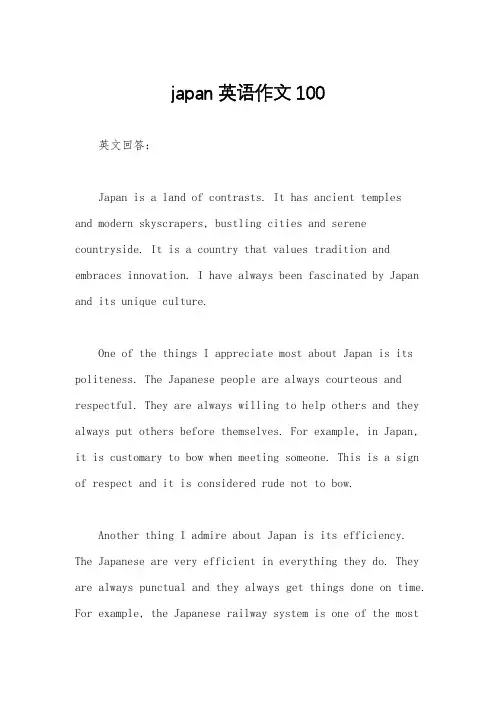
japan英语作文100英文回答:Japan is a land of contrasts. It has ancient templesand modern skyscrapers, bustling cities and serene countryside. It is a country that values tradition and embraces innovation. I have always been fascinated by Japan and its unique culture.One of the things I appreciate most about Japan is its politeness. The Japanese people are always courteous and respectful. They are always willing to help others and they always put others before themselves. For example, in Japan, it is customary to bow when meeting someone. This is a sign of respect and it is considered rude not to bow.Another thing I admire about Japan is its efficiency. The Japanese are very efficient in everything they do. They are always punctual and they always get things done on time. For example, the Japanese railway system is one of the mostefficient in the world. The trains are always on time and they are very clean and comfortable.However, there are also some things about Japan that I find challenging. One of the things I find challenging is the language. Japanese is a very difficult language to learn. The grammar is complex and the characters are difficult to remember. For example, the Japanese word for "cat" is "neko." This word is pronounced "ne-ko." However, the "e" sound in "neko" is very short. It is almost like the "e" sound in the English word "bed." This can be difficult for native English speakers to pronounce correctly.Another thing I find challenging about Japan is the cost of living. Japan is a very expensive country to live in. The cost of food, housing, and transportation is very high. For example, a loaf of bread in Japan can cost up to $5.00. This is much more expensive than a loaf of bread in the United States.Overall, I have a very positive view of Japan. Iappreciate the politeness and efficiency of the Japanese people. I also admire the country's rich history and culture. However, I do find some aspects of Japan to be challenging, such as the language and the cost of living.中文回答:日本是一个充满对比的国家。
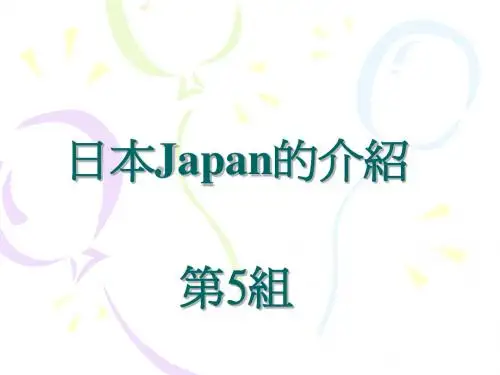
Japan,an island nation in East Asia,is renowned for its rich cultural heritage, technological advancements,and unique blend of traditional and modern lifestyles.Heres a detailed look at various aspects of Japan that make it a fascinating country to explore.Geography and Climate:Japan is an archipelago consisting of four main islandsHokkaido,Honshu,Shikoku,and Kyushualong with numerous smaller islands.Its location in the Pacific Ocean exposes it to a variety of climates,from the cold winters of Hokkaido to the subtropical climate of Okinawa.The country is also prone to natural phenomena such as earthquakes and typhoons due to its position on the Pacific Ring of Fire.History:The history of Japan is marked by periods of significant cultural and political development.From the Jomon period,known for its pottery,to the Heian period,which saw the flourishing of the arts and literature,Japan has a rich historical tapestry.The Edo period,characterized by social stability and isolationist policies,ended with the Meiji Restoration in1868,leading to rapid modernization and industrialization.Culture:Japanese culture is a harmonious blend of the ancient and the contemporary.Traditional arts such as tea ceremonies,flower arranging ikebana,and calligraphy are still practiced today.The country is also famous for its performing arts,including kabuki and noh theater.Modern Japan is a global trendsetter in fashion,technology,and entertainment, with anime and manga enjoying worldwide popularity.Language:Japanese is the official language,with its writing system comprising three scripts:kanji Chinese characters,hiragana,and katakana.The language is known for its complex honorifics and politeness levels,reflecting the importance of social hierarchy and respect in Japanese society.Cuisine:Japanese cuisine is celebrated for its emphasis on fresh ingredients,seasonality,and presentation.Sushi,sashimi,tempura,and ramen are just a few examples of dishes that have gained international acclaim.The concept of washoku reflects traditional Japanese cuisine and was recognized by UNESCO as an Intangible Cultural Heritage. Economy:Japan has the thirdlargest economy in the world,driven by a strong manufacturing sector, particularly in automobiles,electronics,and machinery.It is also a leader in robotics andhas a highly developed service sector.Despite its economic strength,Japan faces challenges such as an aging population and low birth rates.Education:The Japanese education system is known for its high standards and rigorous academic cation is compulsory for nine years,and the country boasts a high literacy rate.Japanese universities are respected globally,with institutions like the University of Tokyo and Kyoto University ranking among the worlds best.Technology:Japan is at the forefront of technological innovation.From the development of electronic devices and highspeed trains Shinkansen to advancements in robotics and artificial intelligence,the country is a global leader in technology.Japanese companies like Sony, Panasonic,and Toyota are household names worldwide.Tourism:Tourism in Japan offers a wide range of experiences,from the bustling metropolis of Tokyo,with its neon lights and skyscrapers,to the serene temples of Kyoto,steeped in history and tradition.Natural wonders such as Mount Fuji,hot springs onsen,and the cherry blossoms sakura in spring attract millions of visitors annually.Social Etiquette:Japanese society places a high value on etiquette,respect,and harmony.Bowing is a common form of greeting,and giftgiving is an important part of social interactions. Punctuality is highly regarded,and public transportation is known for its punctual schedules.In conclusion,Japan is a country of contrasts,where the past and the future coexist seamlessly.Its unique cultural practices,technological prowess,and natural beauty make it a captivating destination for travelers and a significant player on the global stage.。
姓名: 学号: 班级:
Japan's Marketing Environmental Analysis Abstract The marketing environment is a prerequisite and basic security in the region to carry out marketing activities.This article to use PESTEL analysis tools to a rough analysis of the marketing environment in Japan. Summed up the need to pay attention to the problem of marketing activities in Japan, so that enterprises are better able to cope with various challenges in the international marketing activities
Key Word:Marketing Environment Japan PESTEL First, the Japanese political environment Since the nineties, Accompanied by more than ten years of development experience of Japan's bubble economy collapse trough a period of adjustment, Japan has completed the historical process of repositioning and adjustment in the political, diplomatic and security and defense and other fields gradually. Toward political power of the national development strategies and attach importance to-Japanese-US alliance and strengthen the Asian diplomatic foreign policy approach has been basically established. The same time, still exists in the field of political and diplomatic uncertainties and continue to be the subject of political reform, foreign policy there is a big swing space. The new century, Japanese politics has been conservative and radical as opposed to the pattern of post-war conversion to the transition of political pluralism. Although the LDP still maintain the advantages of a party, but has been unable to reverse the chaos brought about by the emergence of strong opposition parties. The impact on the country's political and economic "distortions" in a confrontation between the ruling and opposition political forces of the House and Senate are increasingly expanding, and affect the political and diplomatic decision-making and implementation. Japan's military alliance with the United States continue to strengthen political and diplomatic, China's national strength has increased and the Korean peninsula peace trend as a threat to national security. Security and defense strategies and policies continue to challenge the basic principles of the peace constitution, Eager in the international political and military fields, To expand Japan's international contribution. " Japan in recent years, advocates in upholding the Japan-US alliance as the axis at the same time great importance to international relations based on shared values, emphasis on Asian diplomacy, promoting value and improve relations with China, to attach importance to Japan-US alliance and promoting Asian diplomacy "resonance". The transformation of such a foreign concept to promote Japan to play an active role in East Asia on international issues. At present, the mainstream of political development in Japan is to seek political power, a "normal country" of the national strategic objectives established and has made various political efforts. Adjustment and specific policy formulation and implementation inheritance and continuity of strategic direction in the country concerned from the Koizumi cabinet to the Fukuda government. Second, Japan's economic environment Japan is the second largest economy in the world after the United States. Japan's postwar economic development can be divided into four phases: the post-war recovery period (1945-1955), high-speed growth period (1955-1973), the transition period (1973-1985)? And stable development period (1985 -). Iron and steel, automotive, electronics constitute the three pillars of the industry. ? Number of products in Japan has among the highest in the world. Such as shipbuilding, color television sets, radios and other products has leapt to the world; crude steel, electric power, automotive, computer, petroleum products, cement, paper, sulfuric acid, chemical fiber, etc. account for second place in the world. Japan's machinery industry and construction have a larger development. Japan's scientific and technological level are also included in the ranks of the advanced capitalist countries. The national implementation of welfare policies for the development of old-age career, medical career, to improve the pension insurance system and sustainable medical insurance system. The health care system to implement the national health insurance system. In 2002, households with a monthly average disposable income of ¥ 538,000 ¥ 416,000 of actual expenditures; the head of the household fixed average monthly wage of 367,000 yen, the consumer price growth index was -0.9%. The end of 2002, the average population has beds of 14.5, doctors 2.01. The per capita housing area of 31.37 square meters. As of 2000, the per thousand cars 335.6 Telephone 412? Department, 526 mobile phones. The high penetration rate of television sets and refrigerators, is about 100%. Computer penetration rate of 50.5%, 34% of Internet penetration. Toshiba global markets except Japan is divided into four regions: Europe, America, Asia, China, China is the only market to states, but also following day, the United States, Toshiba's largest independent market. Business product categories, including Toshiba's full line of products, business model involved in the research and development, procurement, production, logistics, sales, service, environmental protection and many other business Third, the Japanese social and cultural environment Japan's traditional culture is colorful, full of national characteristics. It can be said that the Japanese called the world's most rapidly changing countries, the Japanese nation is very conservative, modern Japanese culture is both an expression from a long history and tradition of Japanese sumo, but also has quite a Europeanization of the tendency. Japanese literature, visual arts, and even calligraphy, showing old and new, something to pay the bi characteristics. Old "," "Kabuki", "Bunraku" is the three main traditional forms of Japanese drama, modern theater and music coming from Europe and the United States in Japan's unique geographical conditions and a long history, gave birth to the unique Japanese culture. The most gorgeous flowers to the number of traditional Japanese culture to the world-famous tea ceremony and flower arrangement, two kinds of tastes called art still affects the daily life of the Japanese, and has to go abroad and become a symbol of Japan. The tea ceremony, also called tea (tea), since ancient times by the upper classes incomparable beauty of the ceremony as a favorite. Now, the tea ceremony is used as the training of concentration, or used to cultivate the ritual behavior for the general population are widely accepted. Japan there are many schools to teach the tea ceremony schools techniques, many hotel also has a tea room, you can easily enjoy the performance of the tea ceremony. Ikebana is born as a technique for reproduction of wild flowers in full bloom of a tea room. Due to the different rules and methods of display, flower arranging can be divided into more than 20 kinds of genre, in Japan there are many schools that teach ikebana schools techniques. In addition, in hotels, department stores, public facilities, halls and a variety of places, you can enjoy the beautiful decorative floral art. As the country of cherry blossoms, the Japanese since ancient times, the cherry